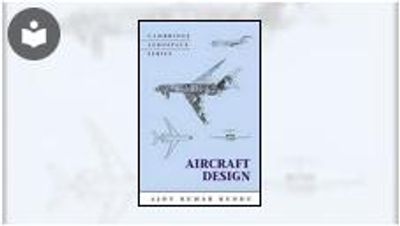Aircraft Design
- 12h 46m
- Ajoy Kundu
- Cambridge University Press
- 2010
Aircraft Design explores fixed winged aircraft design at the conceptual phase of a project. Designing an aircraft is a complex multifaceted process embracing many technical challenges in a multidisciplinary environment. By definition, the topic requires intelligent use of aerodynamic knowledge to configure aircraft geometry suited specifically to the customer’s demands. It involves estimating aircraft weight and drag and computing the available thrust from the engine. The methodology shown here includes formal sizing of the aircraft, engine matching, and substantiating performance to comply with the customer’s demands and government regulatory standards. Associated topics include safety issues, environmental issues, material choice, structural layout, understanding flight deck, avionics, and systems (for both civilian and military aircraft). Cost estimation and manufacturing considerations are also discussed. The chapters are arranged to optimize understanding of industrial approaches to aircraft design methodology. Example exercises from the author’s industrial experience dealing with a typical aircraft design are included.
- Prepares reader for industry standard practices
- Aimed at intensive undergraduate and graduate work
- Extensive illustrations of production aircraft
- Worked-out examples of industry standard aircraft
About the Author
Ajoy Kumar Kundu was educated in India (Jadavpur University), the United Kingdom (Cranfield University and Queen’s University Belfast), and the United States (University of Michigan and Stanford University). His experience spans nearly thirty years in the aircraft industry and fifteen years in academia. In India, he was Professor at the Indian Institute of Technology, Kharagpur; and Chief Aircraft Designer at Hindustan Aeronautics Ltd., Bangalore. In North America, he was Research Engineer for the Boeing Aircraft Company, Renton, and Intermediate Engineer for Canadair Ltd., Montreal. He began his aeronautical career in the United Kingdom with Short Brothers and Harland Ltd., retiring from Bombardier Aerospace-Shorts, Belfast, as Chief Assistant Aerodynamicist. He is currently associated with Queen’s University Belfast. He held British, Indian, and Canadian private pilot licenses. He is a Fellow of the Royal Aeronautical Society and the Institute of Mechanical Engineers and an Associate Fellow of the American Institute of Aeronautics and Astronautics.
In this Book
-
Introduction
-
Methodology to Aircraft Design, Market Survey, and Airworthiness
-
Aerodynamic Considerations
-
Aircraft Classification, Statistics, and Choices for Configuration
-
Aircraft Load
-
Configuring Aircraft
-
Undercarriage
-
Aircraft Weight and Center of Gravity Estimation
-
Aircraft Drag
-
Aircraft Power Plant and Integration
-
Aircraft Sizing, Engine Matching, and Variant Derivative
-
Stability Considerations Affecting Aircraft Configuration
-
Aircraft Performance
-
Computational Fluid Dynamics
-
Miscellaneous Design Considerations
-
Aircraft Cost Considerations
-
Aircraft Manufacturing Considerations
-
References



